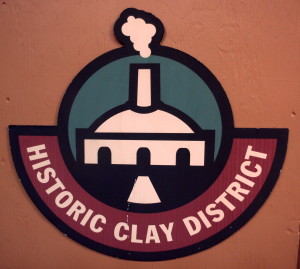This is the article I wrote for Circle Craft Co-operative to thank them for the Residency scholarship. BC Potters Guild has published it in their August newsletter. The illustrated article is too big a file to add here so I’ll put in the text and add some pics afterwards. This June will bring back happy memories for a long time.
Salt-glazed Sewer Pipes: My Inspiration at Medalta
Next to Plainsman Clay’s office and the vast piles of clay in Medicine Hat, Alberta, there is a very large domed kiln. Creeping into the dark interior you find that the walls are completely glazed. Just nearby is a block-long pile of shards and it turns out that imperfect salt-glazed sewer pipes were broken up and just left there.
Down the road is Medalta National Historic Site, where until a few decades ago the crocks for prairie pickles and crockery for Canadian households and the dining cars on the trains were manufactured. There are still several of the round kilns and a wonderful museum showing all aspects of the making of these familiar, but lumpy, stoneware pots.
Thanks to the inspiration and determination of Les Manning, former Ceramics Director at Banff School of the Arts, there is now also the Shaw International Artists-in-Residence Program, housed in a completely reconditioned brick building on the Historic Site.
Having thought about the luxury of an Artist Residency as a chance to devote a serious length of time to doing nothing except making pots, and on hearing news of the splendid studio facilities in Medicine Hat, I decided to apply to go this June. I was one of 13 artists invited to share the studios, with Nelson’s Robin Dupont as an ‘atmospheric firing’ mentor. Also working in studios in the building are Les Manning, Artistic Director Aaron Nelson, studio tech Jenn Demke-Lange and year-long Resident Jim Etzkorn.
We were welcomed so warmly by the Friends of Medalta and the Medicine Hat Potters Club that we felt like celebrities. But soon it became clear that we all were really determined to make the most of the valuable time in this facility, with its glaze room, several electric kilns and the large gas kiln, the gas-fired soda and salt kilns and a wood kiln. Some artists did in fact work all night but certainly we were there long hours. Our accommodation was in 2 or 4-person flats at Medicine Hat College, where we each had our own room and shared excellent kitchen, washer and dryer, freezer, TV and bathrooms, and we had access to a nearby Community Room for students where we had Internet access.
I spoke to last year Residents Amy Gogarty and Gail Carney about it all, especially transportation. I fell exactly in between their advice “Oh it’s an easy bike-ride” and “You definitely need an air-conditioned car to get back and forth between the flats and the Shaw Centre”! Both are true. In the end I walked very occasionally as it took a full hour along Seven Persons Creek, or was given a ride by artists who had their cars with them or shared a taxi. For the final week or so I rented a car.
Back to those sewer pipes. I have occasionally had the chance to take workshops with salt-firing potters: years ago in England with Douglas Phillips in Somerset, with Walter Keeler at ECU and with Jane Hamlyn at the Shadbolt Centre. I keep being drawn back to the luscious orange-peel surface. Recently Vincent Massey gladdened my heart by including some of my work in his Whistler salt kiln. So when Aaron assured me that the salt kiln at Medalta is indeed brand new and available that was the deciding factor in my plan for June. Finding beautiful examples of various sizes and colours of salt glaze on shards in that pile just kept me excited.
I found that loading and firing the salt kiln, even though it is fired with the ever-present gas of this region, not wood, was work for several people. My fellow Residents were keen to help roll salt burritos in newspaper and formed a team when it was time to poke the dampened burritos into the ‘peeps’. And I could not have managed without the enthusiastic help of Saskatchewan potter Claude Morin who, luckily for me, had also decided to make good use of the salt kiln. It was so exciting!

Now that it’s over I shall be hoping that I will have the chance to make more salty pots. I wish I could build a salt kiln in my Port Moody garden! There are many more ideas in my notebook.
I heartily recommend the Residency experience, especially if you have a clear idea of work you want to pursue. The time and space are uninterrupted. Sometimes there’s total satisfied silence in the studio. But it isn’t a workshop: nobody teaches you and nobody comments on your work unless asked. Jenn will answer questions about the glazes there, Aaron advises on firing the kilns but otherwise you need to be confident about your own direction. We were all on different paths, in a companionable way.
Circle Craft Co-operative provided a scholarship to attend this valuable Residency, for which I am very grateful.
To read my blog of this busy month and to see many more photos go to www.gillianmcmillan.com and click on ‘blog’.
